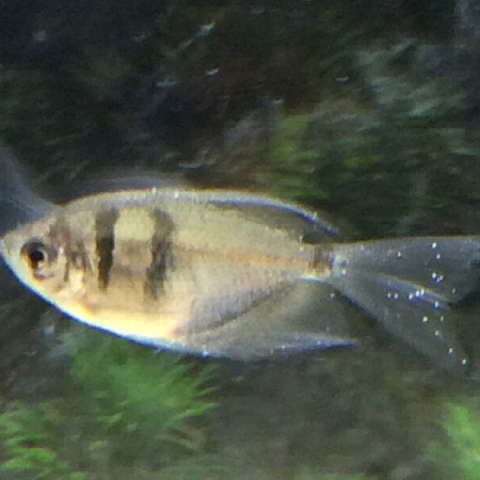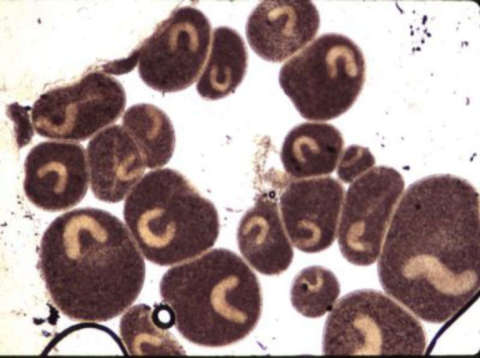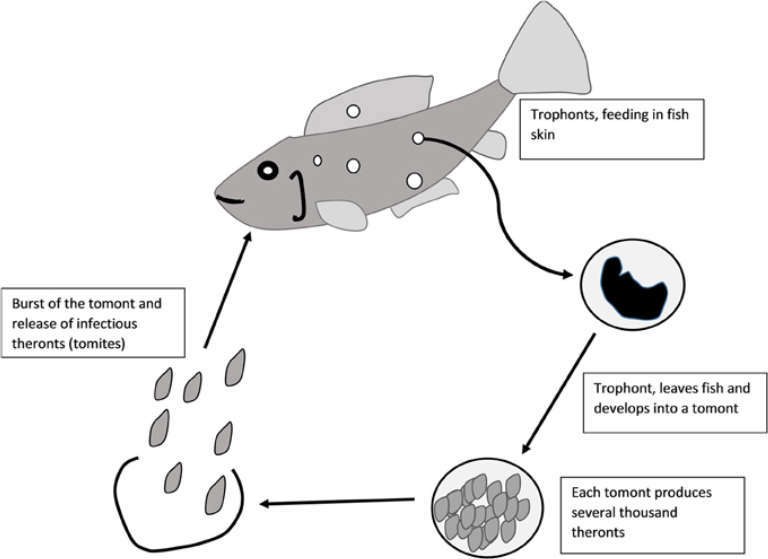While Ich is one of the most common diseases found in tropical fish aquariums, Ich on Endlers is not as common as it is on other tropical fish. This is due to the higher temperatures that Endlers prefer.
Some of the most common reasons Endlers can be affected by Ich are if they become stressed, are exposed to poor water conditions or if their water temperature drops.
What is Ich?
Ich (Ichthyophthirius) is a small parasitic protozoan organism that is found in small quantities in nearly all aquariums.
Ich has several life cycles and is difficult to see except when it is attached to a fish.
When it is attached to a fish it looks somewhat like a grain of salt. Badly infected fish can be covered with small white specks of white.
During this stage Ich has a hard outer shell that makes it nearly indestructible.
Fortunately the life cycle of Ich is relatively short and Ich has other stages that make it fairly easy to treat in a relatively short period of time.

The Stages and Life Cycle of Ich
The duration of the life cycle of Ich is dependent on the temperature of the water. The higher the temperature the shorter the life cycle. At temperatures above 80°F the entire life cycle can take only 3-4 days. Low temperatures result in a longer life cycle taking over two months.
Feeding Stage:

During the feeding stage the Ich is actively feeding on the fish and is known as a trophozoite. This is when it is easiest to recognize as it looks like small grains of salt on the body of the fish. These trophozoite may also invade the gills of the fish making it difficult for the fish to breath and the affected fish will gasp for air.
Fish may appear distressed and may have clamped fins. It is also common for fish that are infected with Ich to scrape it’s body on rocks and substrate as the Ich tends to irritate their skin.
Encapsulated Stage:
After a time (depending on the temperature) the trophozoite will fall the fish and form a hard encapsulated cyst. During this stage the Ich develops into a tomont.
The tomont will attach itself to plants, filters, heaters, gravel, nets, or just about anything in the tank. This is one of the reasons you should have a separate net for each tank.
Free Swimming Stage:
During the encapsulated stage the tomont will reproduce producing thousands of theronts. Eventually the tomont bursts and releases thousands of tiny theronts which become free swimming tomites.
It is during this free swimming stage that treatments are most effective against Ich. If the tomites are not killed at this stage they are likely to find a new host and start the process all over again.
It’s easy to see why fish kept in a confined space such as an aquarium can become overcome in a short period of time by these tiny protozoan parasites.

Why Did I Get Ich?
Nearly every aquarium has Ich in small numbers. Fortunately if you have ever had to treat your fish for Ich it is likely that your fish have developed a degree of resistance to the disease.
When you introduce new fish into your aquarium without quarantining your fish for 2-3 weeks your fish are at a greater risk of developing Ich.
This is because fish can become stressed during shipping or transportation. When fish are transported they may also experience fluctuations in temperature.
Changes in water quality or poor water quality can also can also cause fish to be susceptible to being attacked by the Ich in your aquarium.
Even if there are no changes in your aquarium fish can get Ich if they are stressed from being nipped or attacked by other fish.
I Don’t See Any Ich in My Tank
The only time it is easy to see Ich is when it is attached to a fish. Just because you don’t see any signs of Ich doesn’t mean it’s not in your aquarium.
It’s a good idea to occasionally spend a little time looking closely at your fish for signs of Ich or other diseases that may be attacking your fish.
Untreated Ich can be difficult to spot in a crowded tank but can quickly spread to other fish.
How Can I Prevent Getting Ich?
There are two things that Ich hates and Endlers love:
Heat:
Endlers like warmer temperatures than most tropical fish. This is one reasons that Endlers are affected by Ich less often than other tropical fish.
Aquarium Salt:
Endlers seem to do quite well with the addition of salt in the aquarium water. In fact it may be quite beneficial. Salt can reduce osmotic pressure and help Endlers recover from stress. Salt is also harmful to Ich.
Other Factors
Weak or Stressed Fish
Avoid allowing your fish to become weakened or stressed. Avoid rapid changes in water temperature or keeping your Endlers in cool water.
Maintain a healthy environment for your fish by maintaining low levels of ammonia, nitrites and nitrates.
Don’t keep fish that bully or nip at your Endlers in the same tank.
Prevent Contamination
Keep separate nets and cleaning materials for each tank and allow them to completely dry between uses as Ich cannot survive in completely dry environments.
I Can See Ich On My Endlers. How Can I Treat Ich?
If you see Ich on your Endlers you will want to treat it quickly to prevent deaths and the spread of the disease.
Increase The Amount Of Oxygen In The Tank
Ich stresses Endlers and can attach themselves to the gills of fish. Increasing oxygen in the tank will help alleviate the stress and help them breath easier.
Oxygen can be increased by adding air stones, air discs or other products that help increase the oxygen level of the aquarium.
Raise The Temperature
Increasing the temperature to between 85ºF – 88ºF will speed up the life cycle and help to minimize the amount of time the Ich will remain on the body of the Endler.
If you have other types of fish in your aquaium do a little research on the internet to see if your fish can handle the higher water temperatures.
Higher water temperatures will also help prevent the Ich from reproducing.
Add Aquarium Salt
If you don’t already have aquarium salt added to your aquarium, adding approximately 1 teaspoon of salt per gallon of water will not only help your Endlers recover from stress, it will also weaken the Ich making it easier to eradicate.
Partial Water Changes
While your Endlers are ill increasing partial water changes may be helpful. 25% – 50% partial water changes per day can be very beneficial in decreasing the number of Ich in the water. Don’t forget to add the appropriate amount of aquarium salt to the new water added to the aquarium.
If you are using medication to treat your Endlers perform water changes as recommended by the medication.
Continue Treatment For a Minimum of 10 Days
Using higher temperatures and salt along with partial water changes should make the Ich symptoms disappear in 3-4 days. Although the symptoms may be gone the treatment should continue for a minimum of 10 days in order to make sure the Ich is completely eradicated.
Medications
Sometimes outbreaks of Ich can be somewhat stubborn. If the aquarium salt and high temperature treatment along with partial water changes doesn’t work it may be necessary to use a commercially available Ich treatment or remedy.
When using Ich remedies or treatments you should follow the instructions on the label. These instructions will usually require that any charcoal filtration material be removed. Salt may also negatively affect the effectiveness of some commercially available Ich treatments.
Malachite green or Formalin are strong Ich remedies that may work as a last resort. Use only as directed.
What If I Have a Very Large Tank?
If you keep a small number of fish in a very large tank it may be too costly or impractical to treat the entire tank. Removing all the fish entirely from the large tank into smaller hospital tanks may be a good solution for some fish keepers depending on the number and size of the fish.
These smaller tanks are much easier and less costly to treat. The large tank left entirely with no fish for the Ich to feed on will take care of itself in as little as 4 days if the water temperature is raised to above 80°F as the Ich will have nothing to feed on and the free swimming tomites will die breaking the cycle.

Hello Marty,
Thanks for the information on Ich and how to prevent the disease. My Blue Star Endlers are doing well and I am very happy with them. I have not had any problems with Ich in my tank. Should I start adding Aquarium salt to my 20 gallon High Aquarium and will the addition of the salt harm my Live Plants? The water temp is 80 degrees and I do 20%-30% gravel vac and H2O water change every 2 weeks.
I’m glad you like your Blue Star Endlers. They are such a beautiful fish.
Whether to add salt to your aquarium is really a personal preference. Most aquarium hobbyist believe that salt is beneficial to freshwater livebearers. I also believe that some of the waters where Endlers have been collected in the past contained some salt. We use salt in our tanks as a preventative measure as we wish to minimize the risk having so many fish become ill.
As far as the plants are concerned, yes the salt can be harmful to them depending on the types of plants you have. Most of the plants we keep in our tanks are Cryptocoryne Wendtii. These plants seem to be nearly indestructible and the Endlers seem to love them. Fortunately they are relatively tolerant to the amount of salt we use in our tanks.
If you do choose to use salt remember that the salt will concentrate if you let the water in your tank evaporate or if you top off the water in your tank with water that contains salt.
As far as the rest of the care it looks great. You may try raising the water temperature a little if you get mostly female fry. We keep our water temperature a little higher than that.
Because you are using a 20 gallon high aquarium your Endlers may find one of those 6″ or 12″ blue bubble bars beneficial. The bar placed at the bottom and back part of your aquarium will help circulate the water and help promote oxygen exchange. The Endlers also seem to enjoy swimming against the current that is created.
Thanks for your feedback, it is greatly appreciated. I will most likely start adding Aq salt to the aquarium as I want my Blue Stars to remain healthy and salt seems to be a good preventative measure to minimize fish illness. I will make sure that I top off tank when water evaporates.
The only type of live plants I have in my tank are small/med Amazon Sword(Echinodorous bleheri). I will purchase some Cryptocoryne Wendtii as you mentioned they tolerate salt.
I am using 2 power filters rated for 15 gallon tanks, one on each side of the tank, flow is adjusted to minimize surface current , so it will not be to turbulent for the Endlers. Thanks for the suggestion of 6″ or 12″ blue bubble bar for more circulation and promoting oxygen exchange.
As far as feeding the Endlers, I feed them a well balance diet of Premium Flake Foods, Frozen Brine Shrimp and Flake food with color enhancer twice a day.
Marty, I really appreciate your suggestions and recommendations in the care of the Blue Star Endlers.
The diet should do well for them. We crush our flake food to nearly a powder and there is much less waste as opposed to full size flakes. We also add a small amount of Spirulina powder to the crushed flakes. The smaller size is also ideal for new born fry.
If you do crush the flake like we do remember that it’s much more concentrated so you don’t want to feed as much. Try to feed small amounts several times a day if you can with a minimum of morning and evening.
Frozen Brine Shrimp might not be taken by your Endlers as well as the crushed flakes. I’m not 100% sure about the nutritional value of adult Brine Shrimp. You may wish to try Golden Pearls. They are marketed as a baby Brine Shrimp alternative. Our Endlers love them!
If you go on vacation your Endlers should be fine without food for a week or so once they are established. If they get hungry they will pick at any algae that might be on the class or rocks.
Here are some other ideas for food you may wish to try:
Feeding Your Endlers for Color & Health